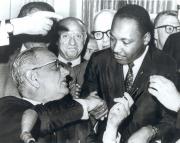45 years later, remembering Dr. King
Listen to the full audio story
- MLK 2 WH.mp3

Clayborne Carson remembers his first political demonstration well. The then 19-year-old gathered with 250,000 others at the March on Washington for Jobs and Freedom and heard Dr. Martin Luther King issue his now famous “I have a dream” speech.
“For me, it was the concluding speech of a long day of speeches,” said Carson, now a Stanford history professor and the founding director of the Martin Luther King, Jr. Research and Education Institute. “I didn’t know it was the “I have a dream” speech. It didn’t have a name. It was just King’s concluding speech.”
Fifty years later, and 45 years after King’s death, Carson says the impact of his life isn’t fully appreciated.
“I think he’s often put in the category of African-American civil rights leader, which would be true, that’s one part of who he was,” said Carson. “But I think that’s kind of like saying Gandhi was an Indian independence fighter.
King’s activism was broader than just the struggle of African Americans in the U.S. He had a sense of the global dimension of the freedom struggle, Carson says, a struggle that continues around the world today
“King had a role in defining it in those broad terms of ‘How do we—on a large scale—turn peasants and the descendants of peasants into citizens?” said Carson.
King’s legacy inspires causes of all kinds today. On Thursday night, his assassination is being marked in Memphis, the city where he was killed, with a labor union rally. And in his hometown of Atlanta, the King Center launched “The 50 days of nonviolence,” advocating against youth violence.
Check out the future home of Annenberg student media:

Wallis Annenberg Hall
(opening Fall 2014)

